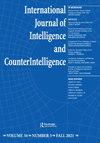Inferences and Consequences
IF 0.5
Q4 INTERNATIONAL RELATIONS
International Journal of Intelligence and Counterintelligence
Pub Date : 2023-07-03
DOI:10.1080/08850607.2022.2066460
引用次数: 0
Abstract
would be ineffective (compared to 10% for liberals). The authors conclude with considerations about how persuadable people are regarding torture. They did not find great cause for optimism for those of us who would like to persuade people that torture is immoral and inefficacious. A maximum of 25% of people are persuadable—not insignificant—but it is much easier to convince them to wrongly embrace the efficacy of torture than persuade them of the truth! Again, some people endorsed torture even when told it would not work, and support for torture also increased when respondents were shown prompts of effective noncoercive interrogation. Other scholars have shown people tend to “double down” on false beliefs when presented contrary evidence when those beliefs are tied up with their identity. For some, willingness to torture may well be one of those beliefs, tied up in some people’s notions of patriotism, toughness, and resoluteness. In all, this short book makes a unique and enlightening addition to the torture debate.推论与结果
将是无效的(相比之下,自由主义者为10%)。作者最后考虑了人们在酷刑问题上的说服力。他们没有找到让我们这些想要说服人们酷刑是不道德和无效的人乐观的理由。最多有25%的人是可以被说服的——并非微不足道——但要说服他们错误地接受酷刑的功效,要比说服他们相信真相容易得多!同样,即使被告知酷刑不起作用,一些人也支持酷刑,当被调查者看到有效的非强制审讯提示时,对酷刑的支持也增加了。其他学者已经表明,当出现相反的证据时,当这些信念与他们的身份联系在一起时,人们往往会“加倍”地相信错误的信念。对一些人来说,愿意使用酷刑可能是一种信仰,与一些人的爱国主义、坚韧和坚定的观念紧密相连。总之,这本短小精悍的书为有关酷刑的辩论增添了独特而富有启发性的内容。
本文章由计算机程序翻译,如有差异,请以英文原文为准。
求助全文
约1分钟内获得全文
求助全文
来源期刊

International Journal of Intelligence and Counterintelligence
INTERNATIONAL RELATIONS-
CiteScore
1.00
自引率
22.20%
发文量
102
 求助内容:
求助内容: 应助结果提醒方式:
应助结果提醒方式:


